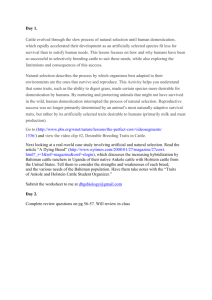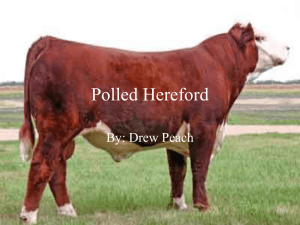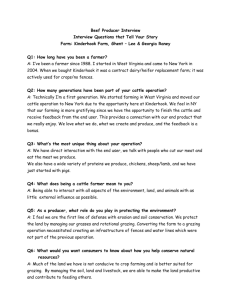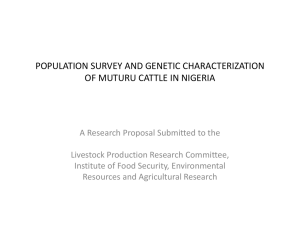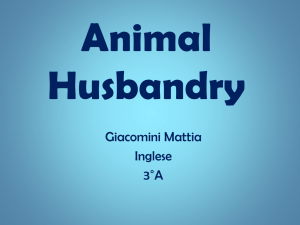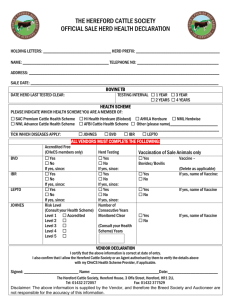shone farm Beef cattle guidelines STRESS Stress occurs in cattle
advertisement
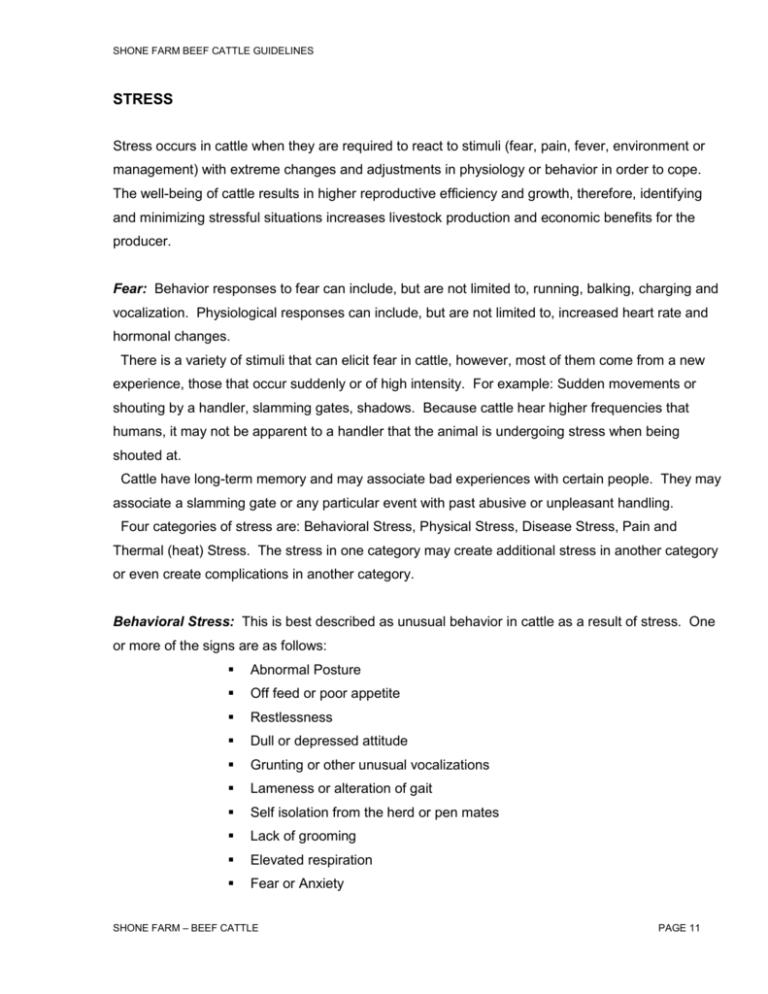
SHONE FARM BEEF CATTLE GUIDELINES STRESS Stress occurs in cattle when they are required to react to stimuli (fear, pain, fever, environment or management) with extreme changes and adjustments in physiology or behavior in order to cope. The well-being of cattle results in higher reproductive efficiency and growth, therefore, identifying and minimizing stressful situations increases livestock production and economic benefits for the producer. Fear: Behavior responses to fear can include, but are not limited to, running, balking, charging and vocalization. Physiological responses can include, but are not limited to, increased heart rate and hormonal changes. There is a variety of stimuli that can elicit fear in cattle, however, most of them come from a new experience, those that occur suddenly or of high intensity. For example: Sudden movements or shouting by a handler, slamming gates, shadows. Because cattle hear higher frequencies that humans, it may not be apparent to a handler that the animal is undergoing stress when being shouted at. Cattle have long-term memory and may associate bad experiences with certain people. They may associate a slamming gate or any particular event with past abusive or unpleasant handling. Four categories of stress are: Behavioral Stress, Physical Stress, Disease Stress, Pain and Thermal (heat) Stress. The stress in one category may create additional stress in another category or even create complications in another category. Behavioral Stress: This is best described as unusual behavior in cattle as a result of stress. One or more of the signs are as follows: Abnormal Posture Off feed or poor appetite Restlessness Dull or depressed attitude Grunting or other unusual vocalizations Lameness or alteration of gait Self isolation from the herd or pen mates Lack of grooming Elevated respiration Fear or Anxiety SHONE FARM – BEEF CATTLE PAGE 11 SHONE FARM BEEF CATTLE GUIDELINES STRESS (Behavioral) – continued In order to eliminate or minimize behavioral stress in everyday living for cattle, there should be adequate food, water, enough area to sleep and lay down and the ability to groom. In handling and restraint, methods and options for the various management practices should be considered and adhered to in order to minimize fear and anxiety within the herd and individual animals. Observations are the key to noticing and identifying stress in cattle. Short-term stress can increase heart rate, respiration, some hormones and blood pressure and can cause an animal to go off feed. Long-term stress may induce changes in immunological response or hormonal secretions which can result in, among other things, less tolerance to parasites and increased susceptibility to disease. Although some management practices (branding, vaccinating, castrating, ear tagging and change of environment) may create short-term stress, the management team must consider the long-term overall benefits these create. Handlers should be aware that all management practices and handling of cattle is stressful, including gathering, moving to new pastures, weaning, separating herd mates and sorting, chutes, head gates and other facility aids. These practices, however, alleviate some long-term stress by creating a safer environment, reducing the possibility of illness, injury and nutritional deficiencies. Physical Stress: The space available to it and the surfaces it comes into contact are the components of an animal’s environment. Factors that affect or that may contribute to physical stress include availability of space, maintenance (safety, cleanliness), flooring, restraint (pen, chutes, head gates, halters) and injuries. Disease Stress: This may be described as stress that results from the onset of and spread of illness or disease. The response of the animal’s immune system will determine if they will succumb to or survive an illness. If the immune system is compromised due to another stressor, the likeliness of survival is diminished. Pain: Receptors located in the skin, muscles, viscera and joints transmit information to the central nervous system when stimulated. An animal perceives pain when this occurs. The animal responds to pain in a similar manner to other stresses through behavioral and physiological changes. Pain symptoms are often more acute and can have a more sudden onset, depending on the situation. SHONE FARM – BEEF CATTLE PAGE 12 SHONE FARM BEEF CATTLE GUIDELINES STRESS - continued Thermal Stress: Animals interact and react to heat in 4 different ways: Evaporation, Conduction, Convection and Radiation. When the animal’s heat gain becomes greater than its ability to create heat loss, the animal will store the increased heat in the form of increased body core temperature. A cattle’s response to heat involves changes in behavior, performance, immediate environment and physiology. Heat stress can be kept to a minimum by creating an environment that can manage heat load, animal behavior and thermal stress and by observing cattle often and noticing when there needs to be a change made to the environment. Behavioral, Physiological and Performance responses to heat stress: The initial response that cattle have to heat is through behavior modification. They will seek out cooler areas and feeding, drinking, standing, lying, locomotive, aggressive and elimination habits (behavior) will change. Grazing patterns in cattle are influenced by heat, therefore, those kept on pasture may exhibit nocturnal patterns. There will be minimal grazing during the hot, daytime hours and more during dusk and dawn. During the day, it is common for them to be idle and/or laying in the shade. This does not mean an animal is in distress. Consumption of water by cattle will increase in a hot environment and this will aid in heat loss via sweating and respiration. An increased core temperature will result in a higher rectal temperature and respiration rate (allowing more evaporative heat loss via upper respiratory passages). An animal that is unable to lower and regulate its temperature overnight is considered a critical situation. An overheated animal will have a limited productivity ability and because the heat will continue to increase, the animal will suffer from stress and maybe even death. Reducing an animal’s Dry Matter Intake (DMI) will decrease its core body temperature, therefore, if water intake isn’t sufficient enough to lower temperature, cattle will reduce food intake. SHONE FARM – BEEF CATTLE PAGE 13




